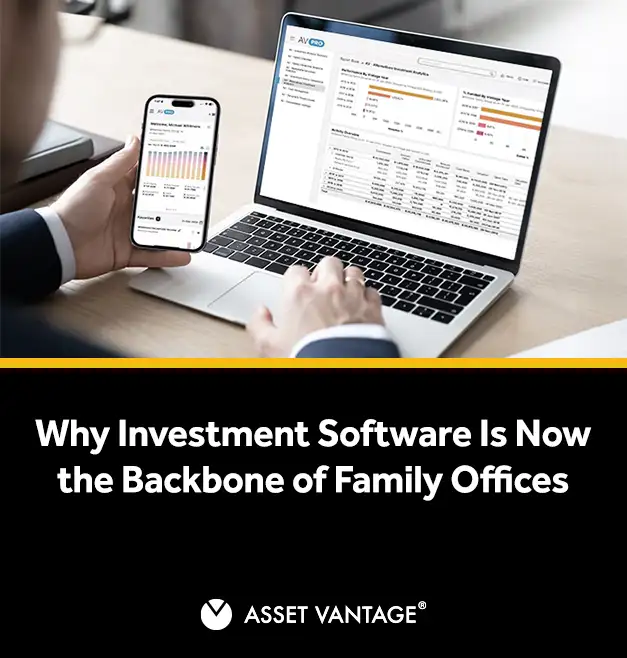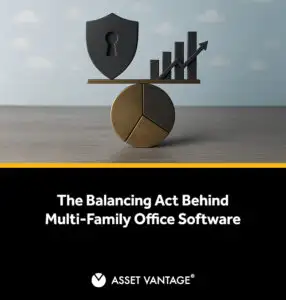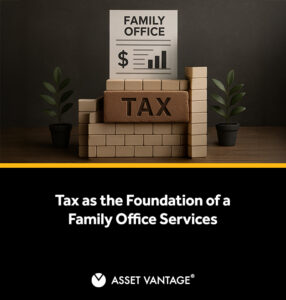Read Time13 Mins
- Why Investment Software Is Now the Backbone of Family Offices
- How Investment Software Goes Beyond Family Office Accounting Software
- Core Features Of The Right Family Office Software
- What is a family office advisor?
- Performance Reporting And Portfolio Management Platform Capabilities
- Managing Alternative Investments And Private Equity Real Estate
- Risk Management Across Multiple Asset Classes
- Audit-Ready Trails For Every Adjustment
- Document Management And Audit-Ready Trails
- Consolidated Reporting Built For Review Meetings
- Data Quality Rules That Catch Breaks Early
- Benchmarks, IRR, And Waterfalls That Reconcile
- Advanced Analytics For Investment Portfolio Analysis
- Delivering For Operators And Business Managers
- How To Choose The Right Family Office Investment Software
- Future Of Family Office Management And Wealth Platforms
- Closing Insight: The Investment Backbone Defines Family Wealth
Why Investment Software Is Now the Backbone of Family Offices
By integrating data with automated data capture, it consolidates positions across custodians, enables asset managers and financial advisors to manage diverse assets, and delivers consolidated reporting that principals can defend.
How Investment Software Goes Beyond Family Office Accounting Software
The difference is stark with alternative assets. A venture capital firm revises valuations or a private equity distribution arrives late, and accounting systems falter. Investment software links portfolio management, performance reporting, and investment data aggregation in real time, so exposures are visible before they become risks. Automated data capture streamlines operations, reduces manual processes, and improves reporting accuracy.
Core Features Of The Right Family Office Software
What is a family office advisor?
Business managers and CIOs need investment data they can defend, performance reporting that withstands scrutiny, and tools that simplify the mess of managing alternative assets. Comprehensive family office investment software supports alternative investment management, delivering analytics and reporting across every asset class in the portfolio.
The right family office investment software automates aggregation across custodians, produces reconciled reports that investment committees trust, and supports complex financial structures without breaking when conditions change. Risk management, audit trails, and document management are not features to tick off a list. They are the foundation of governance credibility.
This section examines the capabilities that separate marketing promises from operational reality: aggregation, reporting, managing alternative assets, risk, and audit readiness. These are not optional tools but the core functions that determine whether a platform can scale with family wealth.
Investment Data Aggregation Across Custodians And Entities
When a custodian file is missing or an FX rate is applied incorrectly, NAVs roll up wrong and the report loses credibility before the meeting begins.
- Consolidate investment data aggregation across custodians and entities into one source of truth.
- Surface exposures in public securities, private equity, and alternative assets in real time.
- Handle complex financial structures without creating reconciliation backlogs.
With robust aggregation in place, family office operations shift from patching errors to presenting a strategy. Controllers deliver reports that trace directly to the source, CIOs explain results without hesitation, and principals see governance reinforced rather than undermined.
Performance Reporting And Portfolio Management Platform Capabilities
To deliver credibility, performance reporting must include:
- Benchmarks are applied consistently across asset classes and geographies.
- Transparent attribution that clearly identifies where returns originated.
- Consolidated exposure analysis across entities, without manual stitching.
Managing Alternative Investments And Private Equity Real Estate
A single capital call posted late can unravel a quarter’s reporting and turn an investment committee meeting into a debate over numbers instead of allocation. Revised private equity valuations or off-cycle real estate distributions leave controllers rebuilding NAVs overnight and principals questioning whether the system is in control at all.
- Automated posting of capital calls and distributions directly into portfolio management.
- Valuation tracking for private equity real estate and venture rounds with audit trails.
- Consolidated reporting of alternative assets so they sit beside public securities in a single view of family wealth.
Risk Management Across Multiple Asset Classes
- Geography and sector exposure maps across public and private holdings.
- Counterparty and credit concentration controls with clear limits and alerts.
- Currency and FX visibility that applies consistent rates and reflects real hedges.
- Liquidity profiles aligning capital calls, commitments, and available cash.
Audit-Ready Trails For Every Adjustment
- Time-stamped records of every change, connected to users and approvals.
- Supporting documentation attached directly to the transaction.
- Valuation and classification history to defend alternative assets over time.
- Audit exports that compress review cycles from weeks to days, allowing for faster review and approval.
Document Management And Audit-Ready Trails
A platform that integrates data keeps records accessible, versioned, and aligned with financial data across asset classes. They should provide:
- Automatic capture and tagging at the point of transaction.
- A version history that clearly shows every amendment.
- Searchable repositories linked to investment and wealth data.
- Audit-ready retrieval where supporting files can be produced in seconds.
Consolidated Reporting Built For Review Meetings
- One-click reporting packs that are accurate across entities and periods.
- Consolidated performance views combining public and alternative assets.
- Scenario comparisons to show shifts across allocations and risk exposures.
- Audit-ready drilldowns so every number can be traced back to the source.
When reporting is truly consolidated, review meetings move from reconciliation to strategy. Business managers present numbers they trust, investment managers explain results without hesitation, and principals leave with decisions rather than doubts.
Data Quality Rules That Catch Breaks Early
A missing FX rate or a stale valuation discovered in the room derails a review and shifts the agenda from strategy to triage. Business managers explain corrections, controllers patch numbers, and principals start questioning whether the reporting can be trusted.
- Automated validation of custodian and market feeds with real-time exceptions.
- Price and valuation checks that flag missing or stale data.
- Cross-entity reconciliations that surface breaks between structures early.
- Audit logs that show how errors were identified and resolved.
Benchmarks, IRR, And Waterfalls That Reconcile
They should provide:
- Standardized benchmarks applied consistently across asset classes and geographies.
- Accurate IRR and NAV calculations that withstand audit scrutiny.
- Distribution waterfall tracking that reflects capital calls, preferred returns, and carried interest correctly.
- Reconciliation checks that flag discrepancies before reports are submitted to committees.
Advanced Analytics For Investment Portfolio Analysis
Analytics that cannot be explained quickly erode trust in the boardroom. When an investment manager cannot demonstrate how returns were generated or explain why risk exposures changed, committees lose confidence, and principals begin to question the integrity of the process.
- Explainable attribution models that clarify what drove returns.
- Scenario analysis to test allocations across geographies and asset classes.
- Risk-adjusted performance metrics that align with benchmarks and strategy.
- Integration with portfolio data ensures that analytics reflect actual holdings, not estimates.
With explainable advanced analytics, CIOs can challenge external managers with facts, committees focus on allocation decisions, and principals leave confident that wealth is managed with discipline rather than opaque models.
Delivering For Operators And Business Managers
What Business Managers Need Day To Day
Transaction processing, bill payment, and expense management are the backbone of daily activity. When these depend on spreadsheets, errors spread quickly, and valuable time is lost reconciling details. In both single-family offices and multi-family offices, families expect accuracy and timeliness, not excuses about broken workflows.
Modern platforms streamline operations by automating approvals, bill pay, and expense capture. With automated data feeds that link directly to consolidated reporting, families gain real-time visibility into their spending and liquidity. Wealth owners see where capital stands today, not what it was last month.
Operating Playbooks That Survive Staff Turnover
Migration Paths That Do Not Disrupt Reporting
Credible platforms design migration as part of governance. Automated data feeds preserve history, reconciliations catch mismatches before they spread, and consolidated reporting continues uninterrupted. Transitions become invisible to principals, who view decisions based on consistent data rather than disrupted records.
How To Choose The Right Family Office Investment Software
The decision is not about features in a brochure. It is about whether the system protects the credibility of family wealth across custodians, entities, and asset classes. Operators must evaluate software solutions based on integration, support, and alignment with family wealth goals. The right platform must integrate smoothly, adapt to complex wealth structures, and provide support that understands the realities of family office professionals. Anything less risks creating new weaknesses instead of solving old ones.
Evaluation Criteria For Best Family Office Software
These criteria apply equally to single-family offices and multi-family offices. Principals and wealth owners want clarity, while controllers need confidence that reconciliations won’t collapse under pressure. Without these standards, reporting becomes a presentation layer rather than evidence that governance can defend.
Proof In Thirty Days Or Less
Promises are easy to make. The real test is whether the platform can deliver within thirty days using real holdings. Pilots should demonstrate operational efficiency with real private equity holdings and multi-asset portfolios. Families need to see reconciliations under pressure and reporting packs that reflect reality, not estimates.
When the proof is real, committees gain confidence early, investment managers know the system can support allocation decisions, and principals avoid investing years into a platform that cannot withstand scrutiny. Without this test, families risk adopting software that fails when it is needed most.
Service And Support That Understand Family Offices
Support determines whether the platform can adapt to family needs over the course of decades. The right vendor brings knowledge of complex wealth structures and family office professionals. A vendor that knows complex wealth structures, family office professionals, and private wealth systems does more than fix technical issues. They anticipate the challenges of succession, prepare playbooks for transitions, and embed practices learned from working with institutional investors.
Families should expect service that streamlines operations, keeps automated data feeds running smoothly, and protects reporting integrity through staff changes or system migrations. The right vendor becomes a long-term partner in governance. For wealth owners, this ensures that strategy and reporting remain aligned; for principals, it secures confidence that decisions rest on evidence, not explanations.
Future Of Family Office Management And Wealth Platforms
Intelligent Family Office Suite And Workflow Automation
Automation has become a governance requirement. Workflow automation reduces manual data handling and supports financial management across diverse assets. An intelligent family office suite creates workflows that replace manual processes with automated data feeds, reconciliation alerts, and exception handling. This shift reduces errors that can undermine trust in meetings, allowing teams to focus on allocation decisions instead of correcting mistakes.
The benefit extends across asset classes. Portfolios that include public securities, private equity holdings, venture capital, and real estate require automation that maintains accuracy across diverse assets. Wealth managers and financial advisors use these tools to focus on strategy rather than data repair. The next wave of automation will include real-time tagging of documents, capital call postings, and compliance checks, so governance discipline is embedded in daily operations.
Integrated Platforms, Cloud Accounting Software, And Private Wealth Systems
Private wealth systems sit at the center of this evolution. They consolidate portfolio data, automate reconciliations, and create audit-ready records that provide a reliable foundation for reporting. They also safeguard continuity. Wealth owners and principals view the same reconciled wealth picture that controllers and business managers rely on. By unifying accounting, reporting, and oversight, integrated platforms remove silos that previously forced families into manual processes and fragmented decision-making.
Advanced Analytics And AI For Wealth Management Services
The future of family office software solutions will be shaped by advanced analytics and artificial intelligence. These tools already assist CIOs and investment managers with portfolio analysis, attribution, and scenario planning. Their real value lies in producing insights that committees can defend, not results that principals distrust.
AI enhances governance by identifying exposures, liquidity pressures, and counterparty concentrations before they become issues. Wealth management services will increasingly rely on predictive analytics and attribution models to help families strike a balance between immediate obligations and long-term objectives. For single-family offices, AI offers scalability without requiring additional staff. For multi-family offices, it ensures consistent reporting and risk oversight across principals and entities.
Evolving Needs Of Single Family Offices And Multi Family Offices
Future requirements diverge across family office models. Single-family offices seek clarity and continuity. They want systems that simplify reporting for wealth owners, automate bill pay and transaction processing, and reduce reliance on individuals. For principals, the test is whether the platform offers transparency without unnecessary complexity.
Multi-family offices face scale and governance challenges. They manage wealth across multiple principals, entities, and jurisdictions, requiring role-based permissions, consolidated reporting, and portfolio management that reconciles exposures across structures. The best family office software provides flexibility: simple enough for a single family office, yet robust enough for multi-family offices without fragmenting control.
Families evaluating platforms should ask how vendors address both models. Future-ready solutions will not be one-size-fits-all. They will provide intelligent family office suites and private wealth systems that adjust to complexity, delivering continuity for single-family offices and scalability for multi-family offices.







